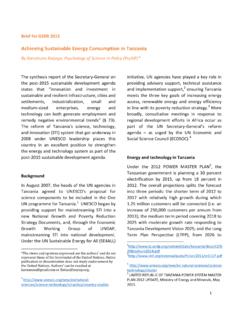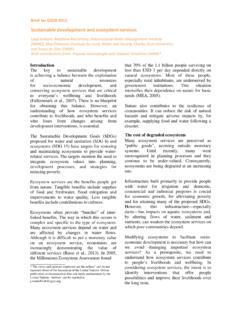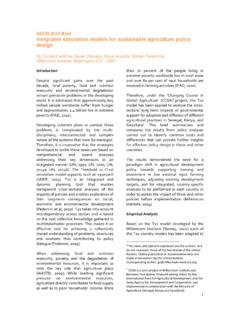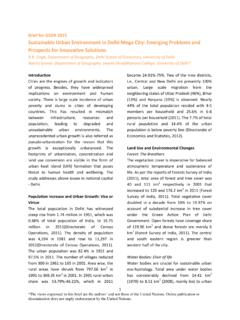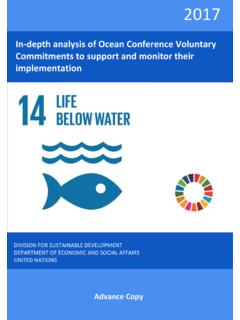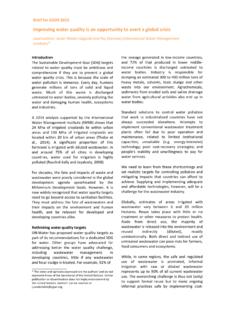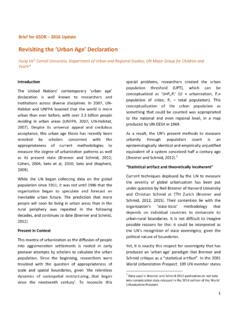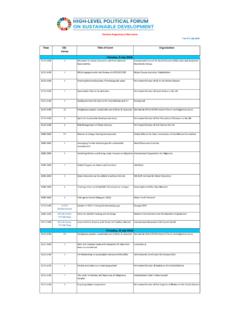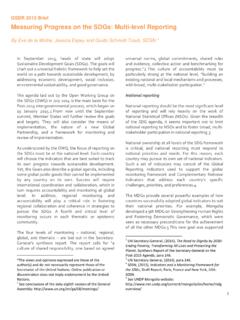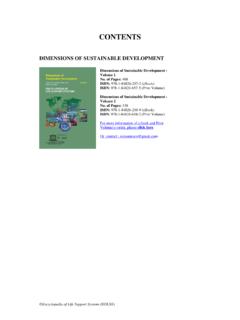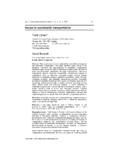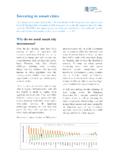Transcription of 81-Siri-Health and Wellbeing in Sustainable Urban Development
1 GSDR 2015 Brief health and Wellbeing in Sustainable Urban Development By Jos Siri and Anthony Capon, International Institute for Global health , United Nations University (UNU-IIGH). Corresponding author Related Sustainable Development Goals Goal 1: End poverty in all its forms everywhere Goal 2: End hunger, achieve food security and improved nutrition and promote Sustainable agriculture Goal 3: Ensure healthy lives and promote well-being for all at all ages Goal 6: Ensure availability and Sustainable management of water and sanitation for all Goal 9: Build resilient infrastructure, promote inclusive and Sustainable industrialization and foster innovation Goal 11.
2 Make cities and human settlements inclusive, safe, resilient and Sustainable Goal 12: Ensure Sustainable consumption and production patterns Goal 13: Take urgent action to combat climate change and its impacts Goal 17: Strengthen the means of implementation and revitalize the global partnership for Sustainable Development Introduction Human futures are Urban futures. During the last decade, the number of people living in cities exceeded the number living in rural areas for the first time in human history (Ash et al 2008). For the foreseeable future, most human lives will be Urban lives.
3 Yet, if anything, these figures underestimate the influence of the global Urban transition on humanity and the planet. While Urban areas occupy just 3% of land surface, they are responsible for perhaps three-quarters of carbon emissions and natural resource utilization (UNEP 2012b). Indeed, during the period encompassed by the Sustainable Development Goal (SDG) framework (2016-2030), the pace and scale of _____ *The views and opinions expressed are the authors and do not represent those of the Secretariat of the United Nations. Online publication or dissemination does not imply endorsement by the United Nations.
4 Author can be reached at Urban Development will continue. It is estimated that by 2050 about 2-3 billion more people need to be housed in cities by more than a million every week (Birch and Wachter 2011) with corresponding needs for infrastructure and services1. It has also been estimated that nearly two-thirds of all Urban extents in 2030 will have become Urban since 2000 (Seto et al. 2012). It is therefore prescient that the UN Open Working Group chose to include a stand-alone goal on cities (Goal 11) among the set of 17 proposed SDGs. Yet current discussions on Sustainable Urban Development tend to center on economy and environment2, rather than on the essential role of cities as human habitat.
5 Cities are for people (Gehl 2010). The way Urban settlements are planned, designed, developed and managed 1 These include housing, transport, food, water, energy, education, health care, waste management, emergency services and social support. 2 Or equivalently, on inclusive growth, poverty reduction, remediation of inequalities, resilience-building, climate change mitigation, etc. with affect human health , Wellbeing , safety, security and opportunity (McMichael 2000). This is important because cities can be made more Sustainable from economic or environmental perspectives and certainly these are critical objectives without necessarily safeguarding human health and Wellbeing .
6 An instructive case study is that of the electric automobile, which is likely to be an element of strategies to reduce greenhouse gas emissions (GGEs) and thus ameliorate climate change. Yet a switch from fossil-fuel powered motor cars to electric motor cars would do nothing to increase active transport and reduce the sedentarism that with poor nutritional habits sits at the heart of global epidemics of obesity and related non-communicable diseases (Woodcock et al. 2009). It would also not change the allocation of space in cities, neither by reducing the amount of land for roads and parking for personal vehicles, which may sit unused for up to 95% of the time, nor by promoting better siting of resources and residences.
7 It would reduce neither congestion nor stress associated with driving3, and it would not open up land for public green space, which has proven health and environmental benefits (Dannenberg et al 2011). While in most cases public transit is the Sustainable Urban transport option, a paradigm that does not have a central focus on human health and Wellbeing may fail to recognize the critical systemic relationships involved and thus the opportunities for identification of strategies that generate co-benefits. 3 In the US, congestion is estimated to account for losses equivalent to of GDP.
8 In Lima, Peru, this figure is as high as 10% (GER Transport 2011). A health -specific goal (Goal 3) is included in the current proposed SDG framework, and indeed such a goal is essential. However, the compartmentalization of objectives required for straightforward collection of internationally-comparable data and monitoring of progress risks reinforcing siloed structures that can overlook systems linkages and lead to Development failure. It is increasingly acknowledged in the scientific community that understanding such linkages is critical to effectively addressing complex real-world problems, not only in Urban health (Diez-Roux 2011; Bai et al.)
9 2012), but in governance (Capon et al. 2009), politics (Jervis 1997), climate change (Proust et al. 2012) and other areas. On this basis, it is imperative that goals, targets and indicators be selected in such a way as to facilitate these understandings. Recognizing the intense negotiations that have gone into producing a global, yet still at times fragile, consensus on the list of proposed SDGs, we do not propose a divisive revision along these lines, Rather, we argue that the broadly-supported proposal for a list of supplementary objectives the so-called dashboard of goals, targets and indicators from which a set of aims and markers relevant in the national context could be selected should be as far as possible structured along these lines.
10 Goals, targets and indicators should be multi-dimensional and information-rich, applying to more than one problem where possible the more such linkages are recognized in planning, the better the likelihood that they will generate usable data. In particular, they should be geared towards inclusion in systems models and flexible enough to fit research and practice in multiple sectors, and they should aim to realize co-benefits benefits accruing from a policy beyond the intended benefit, often or usually in other sectors. Urban transport again provides a relevant example.
